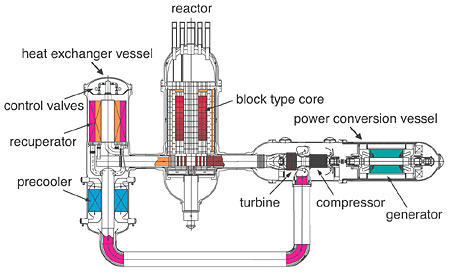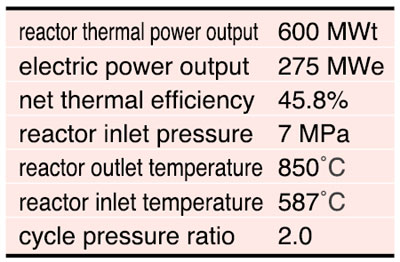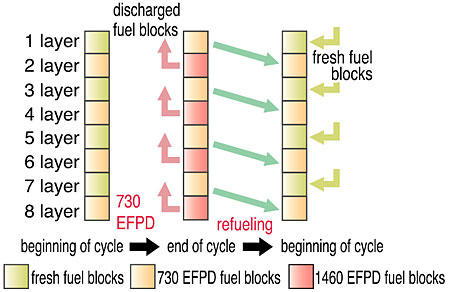The design of the Gas Turbine High Temperature Reactor, GTHTR300, is aimed at higher efficiency to reduce the cost of electricity to below that produced by a steam turbine LWR. The design criteria include improved economics by combining existing technologies without requiring a major breakthrough. The main specifications and a system layout of the GTHTR300 are shown in Table 1-1 and Fig. 1-4, respectively. The reactor has a block type core, which is successfully used in the HTTR. An annular core is adopted to provide 600 MWt and yet to retain passive safety during an accident.
The core design is based on a new refueling method, "sandwich shuffling," which was devised to achieve a burnup of 120 GWd/t and an operational period of 730 Effective Full Power Days (EFPD)/batch (Fig. 1-5). Newly designed coated fuel particles were selected to reduce the fuel failure fraction to be negligible during high burnup operation. Maintenance and inspection procedures were also investigated and simplified. As a result, high plant availability, over 90%, is expected.
In the safety design, "severe accident free" is achieved by taking advantage of the inherent safety of the reactor while minimizing safety equipment. In the safety evaluation, all events currently treated as beyond design basis accidents, but that are more frequent than 10-8/reactor·year were evaluated in the design basis accident to achieve a severe-accident-free reactor.
A nonintercooled cycle was adopted to simplify the system. Reactor vessel cooling by a portion of the low temperature compressor exit flow made it possible to use presently employed LWR reactor pressure vessel materials. Although most designs of current gas turbine high temperature reactors in the world adopt a vertical layout, a horizontal layout of the turbomachine, which is commonly used in an industrial air-combustion gas turbine, was adopted. This made it possible to apply the existing maintenance and inspection methods of an industrial gas turbine directly and to reduce the load capacity requirements of magnetic bearings that support the turbomachine rotor.
With this design, the cost of electricity production is estimated to be below ¥4/kWh, which shows economic competitiveness against LWRs.
This study is entrusted from the Ministry of Education, Culture, Sports, Science and Technology (MEXT) of Japan.
|


